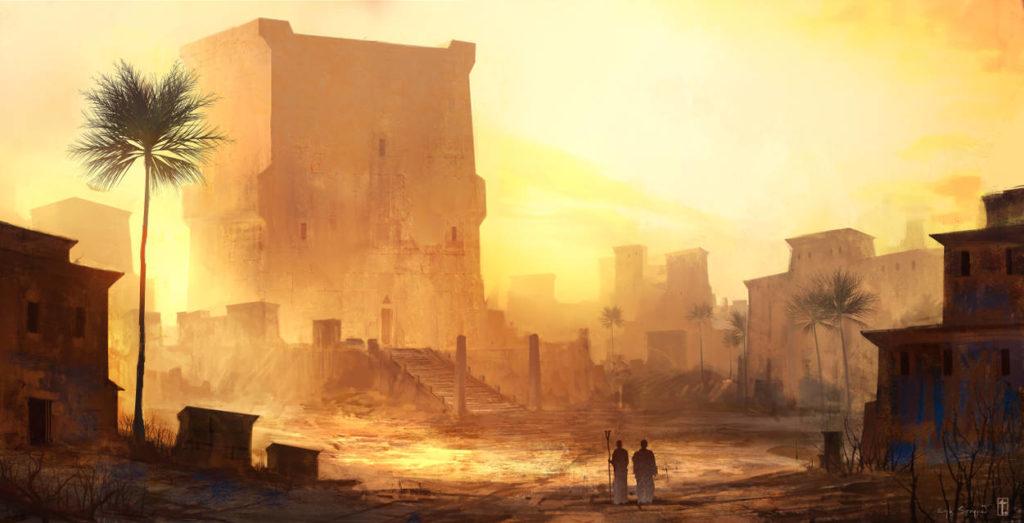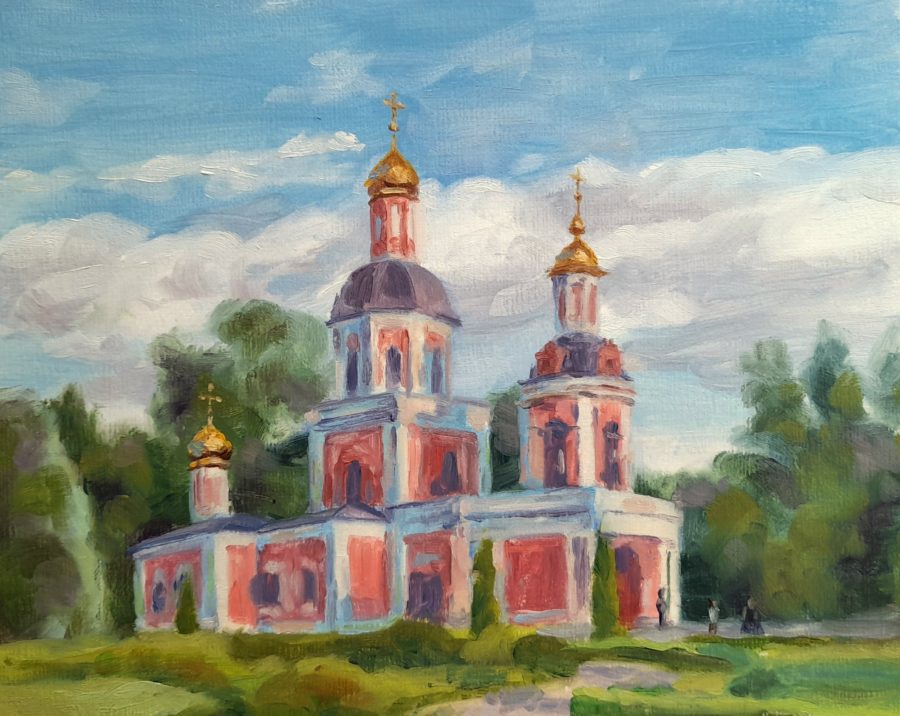The continent is in the midst of an industrial revolution and the age of steam has heralded massive changes to society. As the chimneys have risen, the people have moved to the cities in search of work as production has moved from the cottage to the factory. This paradigm shift in the mortal world has also brought change to the divine. New gods have arisen and the old ones find their realms and worship irreversibly changed.
Reev, God of Machines
His symbols are the wheel and smoke, and he accepts offerings of coal and steel. Reev woke less than sixty years ago in the dark of a mine. Though he could not see anything, he could feel the pulse and noise of the steam engine that drove the mine’s machinery. With the intense weight and power of moving metal, Reev was able to easily push aside Dravit the old forge god and rose a princeling god of industry. He quickly spread word of his divinity with mass produced omens of steam and fire in factories across the continent.
He appears as a young man in an immaculate and tailored suit that fits his lithe and wiry form. The appearance of civility is lost however in his manner. He moves with aggression and blunt purpose, with a seething energy that pushes and shoves just because he can. Reev’s brutal nature is revealed in his coal stained and blistered hands. He has plans and designs for the future and does not care what price other’s might pay to see his vision fulfilled. Engineers will often leave markings on new steam engines calling for Reev’s blessing that the unit will work without fault. Industrialists and businessmen give votive offerings to keep their factories running. The factory workers make shrines at the factory doors and pray it will not be their blood that wets the wheels today.
T’yl’r, Goddess of Chemistry
Her symbols are the flame and the poppy, and she accepts offerings of glass and lead. Where once the answer to things unknown was magic, the intellects of this new age seek answers they can prove. T’yl’r has found herself compelled by the methods scientific and has left her old realms of magic and superstition behind. Her palace in the mountains is now her laboratory, from where she carries out endless experiments into the how and why of things. Previously her missives to her cult were cryptic prophecies, now they are analytical reports on her findings.
Gone are T’yl’r’s elaborate robes and ornate jewellery as they kept getting in her way. She now wears a simple overall with her hair cut intensely short after an errant flame burnt most of it off. Insatiably curious, she becomes consumed by a hypothesis and works without rest until she’s satisfied with her answers. When not in her lab, she is always reading. Followers of T’yl’r seek her support for their experiments and her approval of the results. They make reference to her in their papers and reports, abiding by her tenets that form the core of their scientific method. Her followers are still rebuilding their temple organisations as the shift from magic to science caused nearly all the previous clergy to depart.
Frouzelath, God of War
His symbols are sword and shield and his offerings are blood and gunpowder. Frouzelath is used to change, but it does seem to be happening faster these days. It doesn’t seem that long ago he put away his full plate armour and taught himself how to use a musket. Weapons change, tactics change, but the god of war knows that man’s desire to kill others won’t abate anytime soon. He eyes the new machines of war with suspicion though. Where is the “expertise” in massed artillery, where is the glory in barbed wire? What space is there for bravery when skill no longer means survival?
Tall and broad shouldered, Frouzelath has dropped the muscles needed for wearing armour in favour of a lithe and toned build better suited for pike and shot. His big bushy moustache fills his face and his uniform is a garish mix of colour and gleaming metal. Soldiers of all titles leave Frouzelath offerings at his large temples and the small shrines that are set up before major battles. He’s more favoured by the rank and file than the officers as he is seen more as a fighter than a thinker. It’s common to see soldiers drawing little swords and shields on their weapons to invoke Frouzelath’s power.

Arai, the Goddess of Finance
Her symbols are a coin and the handshake and her offerings are pennies and mint. Merchants and businessmen have always been ones for complicated deals and lengthy agreements, but the modern ways of finance are even more so. There are so many new variations on derivatives, equity, and debt that it all became quite impossible for Arai and her priests to keep track of it all. She responded by adopting and championing the formation of exchanges within her temples. This keeps everything literally under one roof and gives Arai’s respectability to the contracts drawn up within. Arai is looking with interest in how she could incorporate the telegraph into her realm.
A workaholic, Arai spends nearly all of her time tending to her realm. When not actively overseeing the exchanges, she’s studying economic data or reviewing company reports. Rest is for the unimportant. When she does make her rare personal appearances, she dresses in resplendent gold with rainbows of jewels. Arai’s name is called upon by merchants to oversee the honouring of contracts that are sealed with a special handshake using wooden coins embossed with rainbows. Her clergy administer the exchanges, resolve contract disputes. and take their cut of the offerings. The cult’s jargon is becoming ever more difficult to understand.
Deanseth, the Goddess of Information
Her symbols are pen and paper and her offerings are paper and ink. As villages became great metropolises, as chiefs became emperors, and as market stalls became corporations more and more information was demanded and recorded. This continual accumulation of knowledge has brought with it power and importance for Deanseth. Where once only a few old men in libraries paid her worship, now there are thousands of scribes, scholars, and solicitors invoking her to keep their documents in order.
Deanseth is fussy, fastidious, and precise. Everything must be in good order and arrive in good time otherwise something important might be missed. She dresses in a high quality suit with precise lines and carries a messenger bag filled with paper and pens. The only ostentation on her is a steel pocket watch of exceptional quality. All those who record and organise documents and information find it in their best interest to make offerings to Deanseth. Her symbols are found on all filing cabinets and most offices will have a little altar on a window sill. Those about to deal with bureaucracy give offerings for safe passage and all fear a visit from her auditors.
Gidie, the Goddess of Art
Her symbols are words and notes and her offerings are story and song. After hundreds of years of orthodox and authorised artwork, Gidie cannot fully explain without bubbling over into happy noises how joyful she is at the explosion of art of the industrial revolution. Art is freeing itself from being tied to toil for a church or a patron’s ego. Now it is about symbolism and romanticism and expressionism and now there’s this new idea about freezing light onto metal. This freedom has seen Gidie sponsoring artisans in cooking, fashion, gardening, ceramics, and many other crafts.
Irrepressibly bubbly and enthusiastic about art, Gidie adores pretty much everything that anyone has but any thought or effort into. Of the few things that will cause her to become angry, wanton or mindless destruction is sure to incur her wrath. She is always wearing the latest clothing trends and loves to experiment with new looks. Gidie’s temples are more galleries than temples. They are filled with an ever changing collection of art that is curated by the priests under her guidance. Artists and Artisans pray to her for inspiration and beg for her forgiveness if struck by blank imaginations. As Gidie has a sweet tooth, it is common to find offerings of sweets on her smallest shrines.
Dis, the God of Death
His symbols are insects and a staff, his offerings are toys and incense. Dis is not the cause of death. They are the guide of the departed, a psychopomp who guides souls onwards to their afterlife. This hasn’t changed with the industrial revolution but they are now increasingly busy. Where once a fire or a plague would send a few dozens to the grave, in the crowded dirty cities thousands meet untimely ends. Dis is not happy that there are so many new ways to die and so many old ways happening so much more. They have great hopes in the burgeoning field of modern medicine but are kept fearful by the doom of industrial warface.
They appear as an innocent child of no more than ten years old with five shadows. They wear simple robes that cover them entirely leaving only glimpses of the form beneath. Dis is almost always calm, but this hides a deep sadness at the nature of the role and realm. They cherish any time they get to spend with living mortals and are often told how good a listener they are. The priests of Dis’ cult are scarce because there are few who wish to so closely associate themselves with death. The priests give the final rites to the dying and temples of Dis always have beds available to make a person’s last days comfortable. Dis discourages offerings to them directly and instead encourages petitioners to give to those in need.
Image Credits – Trinity Church Sviblovo Manor by Khovss – CC-BY-NC-SA-3.0 – Temple of Triangle by TyphonArt – CC-BY-NC-ND-3.0

